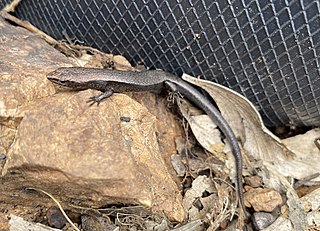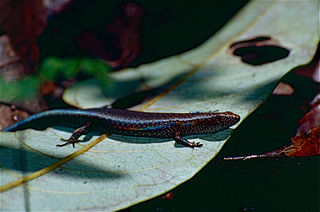Anomalopus mackayi, commonly known as the five-clawed worm skink, long-legged worm skink, and MacKay's burrowing skink, is a species of smooth-scaled burrowing skink, a lizard in the family Scincidae. The species is endemic to eastern Australia.
Allan's lerista, also known commonly as Allan's skink and the greater robust fine-lined slider, is a species of skink, a lizard in the family Scincidae. This rare species is endemic to Queensland, Australia.

White's skink, also known commonly as White's rock skink, is a species of lizard in the family Scincidae. The species is endemic to Australia.
The Satinay sand skink, also known commonly as the Fraser Island sand skink, is a species of lizard in the family Scincidae. The species is native to Australia.

Morethia boulengeri is a species of lizard in the family Scincidae. The species is endemic to Australia and Indonesia.
Anomalopus swansoni, also known commonly as the punctate worm-skink or Swanson's burrowing skink, is a species of lizard in the family Scincidae. The species is endemic to Australia.

The eastern mourning skink, also known commonly as Coventry's spinytail skink and the swamp skink, is a species of lizard in the family Scincidae. The species is endemic to Australia.

Carinascincus coventryi, also known commonly as Coventry's window-eyed skink and the southern forest cool-skink, is a species of lizard in the family Scincidae. The species is endemic to Australia.
Lampropholis adonis, also known commonly as the diamond shielded sunskink and Ingram's litter skink, is a species of skink, a lizard in the family Scincidae. The species is endemic to Queensland in Australia.
Lampropholis caligula, also known commonly as the montane sunskink or the montane sun skink, is a species of lizard in the family Scincidae. The species is endemic to New South Wales in Australia.

Lampropholis coggeri, also known commonly as the northern sun skink and the rainforest sunskink, is a species of lizard in the family Scincidae. The species is endemic to Queensland in Australia.
The plain-backed sunskink is a species of skink, a lizard in the family Scincidae. The species is endemic to Queensland in Australia.

Pseudemoia pagenstecheri, also known commonly as the southern grass tussock skink or the southern tussock grass skink, is a species of lizard in the family Scincidae. The species is endemic to Australia.

Pseudemoia rawlinsoni, also commonly known as the glossy grass skink and Rawlinson's window-eyed skink, is a species of lizard in the family Scincidae. The species is endemic to Australia.
The Fortescue three-toed slider is a species of skink, a lizard in the family Scincidae. The species is endemic to Australia.
Lerista baynesi, also known commonly as Baynes' lerista and Bayne's slider, is a species of skink, a lizard in the family Scincidae. The species is endemic to Australia.
Lerista christinae, also known commonly as the bold-striped slider and Christina's lerista, is a species of skink, a lizard in the family Scincidae. The species is endemic to the Australian state of Western Australia.
The nubbinned fine-lined slider is a species of skink, a lizard in the family Scincidae. The species is endemic to Queensland in Australia.

Lerista walkeri, also known commonly as the coastal Kimberley slider and Walker's lerista, is a species of skink, a lizard in the family Scincidae. The species is endemic to Australia.
Lerista wilkinsi, also known commonly as the two-toed fine-lined slider and Wilkins' lerista, is a species of skink, a lizard in the family Scincidae. The species is endemic to Queensland in Australia.









